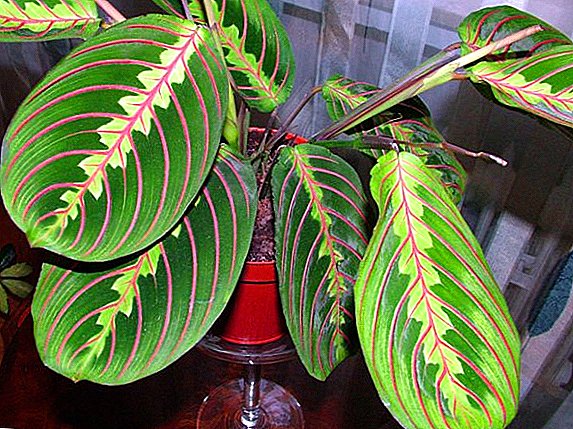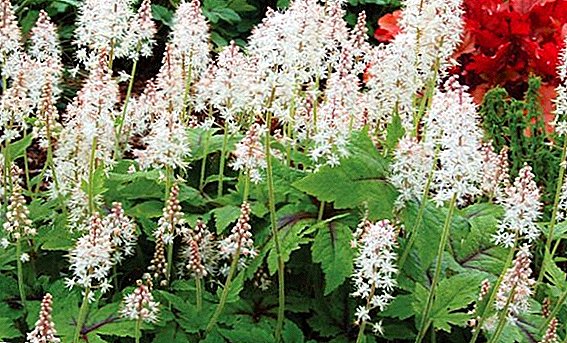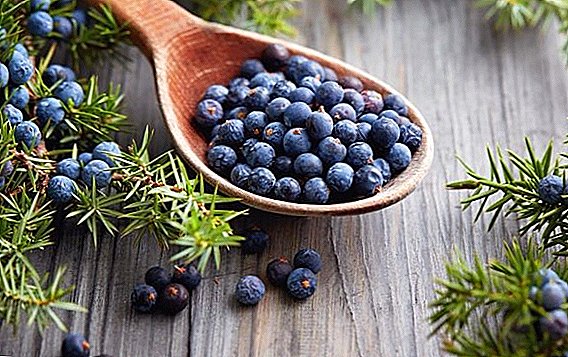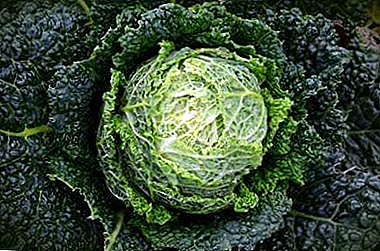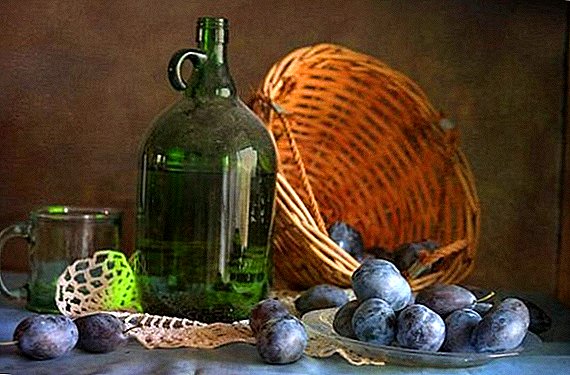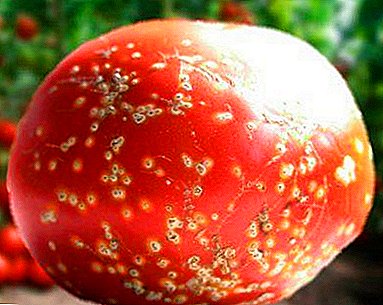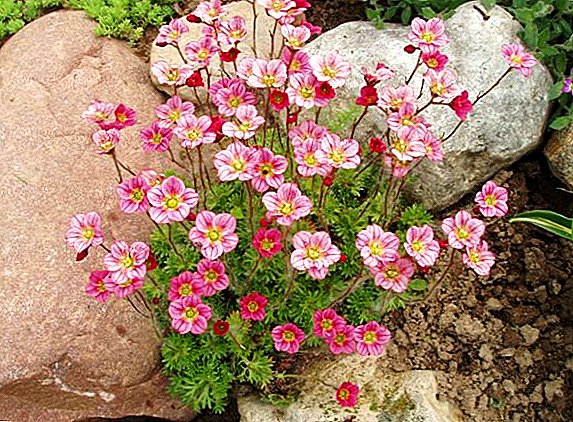 About 600 species, united in 30 genera, made up a family room sausage - plants, really breaking stones in which it grows. The homeland of saxifrage growing on the entire planet is considered to be high mountainous areas on both sides of the equator. Almost all types - perennial plants with whole, feathery or palmate leaves, single flowers or beautiful buds.
About 600 species, united in 30 genera, made up a family room sausage - plants, really breaking stones in which it grows. The homeland of saxifrage growing on the entire planet is considered to be high mountainous areas on both sides of the equator. Almost all types - perennial plants with whole, feathery or palmate leaves, single flowers or beautiful buds.
Did you know? Stems of saxifra grow to a meter and a half.
Optimum conditions for keeping saxoproteins in the house
In landscape design, as well as in nature, care for saxifrage is almost not needed. And in the apartment, she also does not require special care.
Location and lighting
It is desirable that the place in the house for saxifrage was shaded. Too bright lighting will make the leaves fade. Experts advise to stir it in a hanging pots. More aesthetic, it will look together with a blooming petunia.
Temperature
The optimal mode for growing stoneframe in the range from +13 to +18 °. In the winter - not below + 6 °, in the summer not above + 20 °. The warmed air above this limit will cause the leaves to fade, and it will be incredibly difficult to restore the natural decorative coloring to them. A moderate temperature allows the plant to feel quite comfortable and in a dry atmosphere.
Comprehensive care for saxifrage at home
Landing of saxifrage do for good drainage, otherwise it is difficult to avoid rotting of the roots.
Watering mode: summer-winter
For 4 months, starting in March, it is necessary to water the stonegrass regularly (2-3 times a week). Drying of the soil is permissible to a depth of no more than 3 cm.
Important! The signal for the next irrigation is dry topsoil.The soil should not lose moisture at other times, but the number of waterings can be reduced to 3 times per month.
Air humidity
 The plant confidently feels surrounded by a moderately dry atmosphere. At the same time, it responds well to high humidity. Spraying the leaves of saxifrage need spring and summer. This should be done in the morning or in the evening, so that drops of water, having turned into lenses, do not cause burns.
The plant confidently feels surrounded by a moderately dry atmosphere. At the same time, it responds well to high humidity. Spraying the leaves of saxifrage need spring and summer. This should be done in the morning or in the evening, so that drops of water, having turned into lenses, do not cause burns.
To maintain the optimum moisture concentration, a flower pot can be placed in a wide dish, covered with moist expanded clay.
Did you know? Spray the plants need soft otstoyannoy or rainwater.
Top dressing: what and how often
The saxifrage must be fed (first time - a week after landing). In the spring - 2 times a month and 4-5 times for the rest of the time. From October to February, fertilizers are not needed at all.
From the liquid fertilizer purchased at the store, a weak solution is made, with a 2-fold reduced concentration. Used complex tools, bone meal, superphosphate. Nitrogen fertilizers are not used. Without food, shoots will start to grow randomly, and the flowers may not form at all.
All the details of stonework
 There is no hard transplant schedule for growing saxifrage. The prerequisite is the complete entanglement of the roots of the plant with an earthen coma, and the cramping that has occurred in the flowerpot. When carrying out transplantation during flowering, flower stalks are removed. If necessary, use shallow dishes and humus soil with medium acidity.
There is no hard transplant schedule for growing saxifrage. The prerequisite is the complete entanglement of the roots of the plant with an earthen coma, and the cramping that has occurred in the flowerpot. When carrying out transplantation during flowering, flower stalks are removed. If necessary, use shallow dishes and humus soil with medium acidity.
A pot of stonefrike must have a hole to remove excess moisture. It can be placed no more than two rosettes of the flower. For mandatory drainage take expanded clay or gravel. The composition of the soil can be different. One of the options is equal parts of sand, peat, humus, leaf and sod land. You can also use a mixture of coarse sand and turf land with peat or humus in a ratio of 1: 1: 2.
Reproduction of saxifrage at home
The peculiarity of kamnelomki is that its reproduction occurs, depending on the season, in 3 different ways.
Seeds
Seed material in most cases for a long time prepared for germination. Since April, it is processed by cold. Seeds are put on the surface of the moistened soil laid in a small dish. The container is placed for 14-21 days in the refrigerator, and then placed on the window sill closer to the light.
 At a temperature of + 18-20 ° in a week you can observe the first shoots. When a second sturdy leaf appears, the shoots swoop into larger boxes. In early summer, you can land, leaving intervals of 8-10 cm. It is advisable to do this on slopes or in crevices between the stones. Remaining soil on the roots do not need to be removed.
At a temperature of + 18-20 ° in a week you can observe the first shoots. When a second sturdy leaf appears, the shoots swoop into larger boxes. In early summer, you can land, leaving intervals of 8-10 cm. It is advisable to do this on slopes or in crevices between the stones. Remaining soil on the roots do not need to be removed.
Cuttings
This process, which is considered optimal, takes 9-10 months from grafting in June-July to disembarking in spring. To begin with, after flowering is completed, a part of the cushion is separated and divided into two centimeter sockets.
They are cleaned from the bottom sheets and planted in the soil mixture. Shadow and coating (film or glass) are necessary for normal maintenance. New side sockets indicate formed roots. Rooted cuttings cover for the winter with a layer of foliage.
Dividing bush
 The easiest method. Produced after a flowering period. Adult flowers should have more rods of sockets. Selected healthy bushes plentifully watered. Processes separated from the mother plant with a sharp knife or scapula with roots and leaves and additional sockets are planted in the shade.
The easiest method. Produced after a flowering period. Adult flowers should have more rods of sockets. Selected healthy bushes plentifully watered. Processes separated from the mother plant with a sharp knife or scapula with roots and leaves and additional sockets are planted in the shade.
The surrounding soil must be loosened and watered throughout the summer. After leaving the temporary shelter, new plants are taken to their permanent residence in the spring.
Frequent problems, diseases and pests of stoneline
Of the problems most known spider mite, fungal diseases (powdery mildew)against which substances containing copper are used.
Important! Heat and dampness is an optimal habitat for pests.Chervets clean manually, and process the flower anticoccides. "Pyrimor" will be needed to protect against green aphids.
Especially it is necessary to be afraid of root rot, which is sometimes impossible to win. In this case, they act radically - they produce cuttings, separating healthy parts from diseased parts and planting them.
 The problems arising in the process of growth of stone-sawing stone are solved by eliminating the corresponding causes. The extrusion of leaves and the lack of flowering, as a result of the lack of useful substances, is treated with additional feeding. When slowing growth and tarnishing of the veins on the leaves, you need to increase the lighting, and fading leaves will help lower air temperature.
The problems arising in the process of growth of stone-sawing stone are solved by eliminating the corresponding causes. The extrusion of leaves and the lack of flowering, as a result of the lack of useful substances, is treated with additional feeding. When slowing growth and tarnishing of the veins on the leaves, you need to increase the lighting, and fading leaves will help lower air temperature.
Contemplating the stern beauty of saxifrage for many years, flower lovers invariably stay in a good mood.


